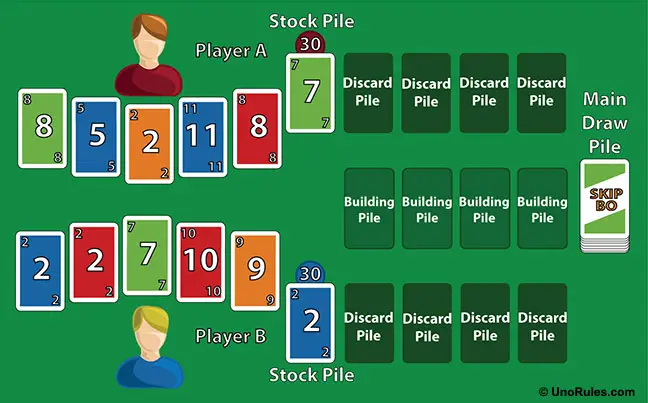
However, each player will be building their discard piles as well.Īt the end of your turn, you can discard any card to one of your discard piles. When a pile has a completed sequence, it is removed, and the cards are added back to the draw pile. All players can use the building piles, but cards need to be placed in sequential order 1 to 12. Building piles can only be started with a number 1 card or a Skip BO card. In the center of the playing area, you’ll need space for 4 building piles. These cards are the draw pile, and now you are ready to play! Playing Skip BO The remaining cards in the deck are then placed in the center. Every player should then turn their first card face up. This pile of cards becomes your stockpile. Once the cards are dealt, they should be placed face down in front of each player. So, be sure to check it out if you’re thinking of having a team game. We have a dedicated section for team play at the end of the guide. If you are playing Skip BO in teams, then each team member will have their cards. You can reduce the number of cards by 50% if you want a faster game. Now to understand how many cards should be dealt, follow the table below. The player with the highest numbered card will be the dealer. The first thing to do is pick a dealer to do this, every player should choose a shuffled deck card. Setting up a game of Skip BO is relatively simple once you know the rules.

During the game, you’ll effectively be racing against other players to be the first to get rid of all your cards. In Skip BO, you’ll start the game with a stockpile of cards. Skip BO’s aim is the same as many sequence games you want to be the first player/ team to play all your cards. While very young children may prefer this version, most children aged 6 and above should be fine with standard Skip BO, especially if you follow the rest of our guide to learn all about the rules! But the main difference is the graphics and slightly simplified gameplay. There is a junior version available as well. However, the most common option will be a standard pack of Skip BO cards. There is even a special tin version of Skip BO available, and you can even get it in a double-pack with Uno. While Skip BO isn’t quite as popular as Uno, it’s still got a loyal fanbase, and you’ll find a few different card sets available. While fans of Uno and other spin-offs like Dos will certainly enjoy Skip Bo, it’s simple and easy to learn for beginners as well. You can also alter the number of cards given out if you want a faster game as well. The rules also change slightly depending on the number of players. If you’re the first player or team to play your cards, you win! Now Skip BO is a very casual game ideal for family game nights, and there are several different ways to set it up.

Skip BO’s aim is simple you need to play your cards sequentially to get rid of them. Skip BO is designed similarly to Mattel’s Uno sets. Skip BO was first published in 1980 and now, like many games, is owned by Mattel. So, let’s take a more in-depth look at how the game works.
My first skip bo rules how to#
But we aren’t here to share the history of Skip BO we are here to tell you how to play. It’s interesting to see how older games can inspire new ones. This fun sequence card game is based on Spite and Malice, which is based on another classic playing card game called Russian Bank. If you like Uno, then you’ll probably love Skip BO! The game was created by the same team, after all.


 0 kommentar(er)
0 kommentar(er)
